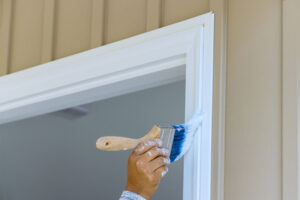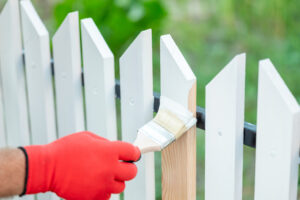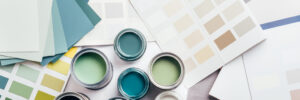
Best Paint for Trim and Baseboards
Baseboards and trim can elevate the appearance of your home’s interior, but even the most ornate trim piece will look dilapidated if it is not
Baseboards and trim can elevate the appearance of your home’s interior, but even the most ornate trim piece will look dilapidated if it is not painted properly. While the skill of the painter certainly comes into play, the type of paint you use can also have a large impact on the finished product. With this guide you’ll learn which is the best paint for trim and baseboards, and how you can use your paint selection to give an even more polished and finished look to your home.
If you walk down the paint aisle at Home Depot, Lowe’s, or any other home improvement store, you may be overwhelmed with all of the options available. While there are many different variations and subsets to paints, they can largely be broken down into two classes: water-based and oil-based.

This is the most common type of paint, and the most versatile. They are the preferred type of paint for plaster and drywall on the interior, and all kinds of siding on the exterior including plaster,stucco, wood, and aluminum.
Water-based paints can be divided further into latex paints and acrylic paints – but you’ll see that this was never quite an accurate distinction. All modern water-based paints contain some amount of acrylic polymers. These polymers are what allow paint to form adhesions with itself and the material it is coating.
Acrylic paints are made of virtually 100% acrylic polymers, which makes them the most durable of the water-based paints. These paints also contain more volatile organic compounds (VOCs), which evaporate from the paint at room temperature and are released over time as the paint dries. Aside from leaving that bitter, acrid smell often associated with paint, VOCs can also cause respiratory and other symptoms if you are exposed to them for too long without adequate ventilation. They are harmful to the environment as well. Latex paints still contain acrylic polymers – but in a mix with latex. Due to the lower ratio of polymers, latex paints are not as durable. The upside is that they are generally available at a requires the durability of 100% acrylic. Due to the lower amount of acrylic polymers, this paint also releases fewer VOCs and each coat dries faster.
Now that you know the difference between latex and acrylic paints, you may be wondering
when you should reach for them.
Latex paints are best for projects that are purely decorative, or do not need the paint to stand up to weather or heavy wear and tear. The following are generally the best applications for latex paints:
100% acrylic paints, on the other hand, are best for projects that will be subject to temperature and moisture fluctuations, or are in more heavily-trafficked areas. Acrylic polymers also bond better to metal than latex. The following are generally the best applications for acrylic paints:
Since baseboards and door, window, and decorative trim take more wear and tear over time, the enhanced durability makes this paint the preferred option for these surfaces over latex paints.

This is the other class of paint, and historically oil-based paints were hand-made by mixing linseed oil or other oils with the paint pigment and a binder. Their consistency and quality varied greatly depending on who made them, but Sherwin-Williams changed that when they became the first company to commercially produce consistently high-quality oil-based paints. Oil paints offer several advantages over water-based paints. The paint goes on thicker, making it easier to do projects with fewer coats while achieving an even smoother finished surface. The painted surface also does not technically dry, but instead it oxidizes and hardens. This gives the finished product a hard, smooth coat that is even more durable than acrylic without being tacky or dull. The dried paint is also easier to clean than water-based paints, and is more resistant to scuffing and peeling. Compared to acrylic, oil-based paint is even better at bonding to metal. With all that said, why would you reach for water-based paints? For one, oil-based paints take a long time to dry. The average water-based paint coat will be completely dry by 4 hours, whereas with oil paints that time goes up to 24 hours. Water-based paints also drag less as you’re applying them, making the paint easier to spread. While the paint itself will remain intact, a high-gloss finish on oil-based paints will eventually fade – whereas with water-based paints the sheen will not be quite as high to start, but it will stay the same finish for longer. Oil-based paints are more prone to yellowing over time, and they do not resist temperature fluctuations and UV stress as well as water-based paints. Finally, and importantly, oil-based paints involve much higher levels of VOCs even than acrylic paints, making them harsher on the environment and the people working with them. As such, different regulations and restrictions have changed the way these paints are made and used and have caused them to fall out of favor in recent years compared to acrylic paints.
Having gone through the pros and cons compared to water-based paints, here are the
applications where oil-based paints can still be the best:
● Metal surfaces
● Bathrooms
● Kitchens
● Cabinets
● Furniture
● Trim and baseboards
Due to the ability to have a high-gloss finish and the resistance to scuffing and peeling, oil-based paints are often chosen for trim pieces and baseboards around the home.

Both oil-based paints and acrylic paints have their benefits, and both can be used on your trim and baseboards to give that polished, durable finish you’re looking for. So how do you choose?
For one, if you’re working under cost constraints, you will save money in the long-run by choosing acrylic paint. These paints not only are cheaper themselves but they work best with synthetic bristle brushes. Brushes with synthetic bristles are cheaper than natural bristle brushes, and oil-based paints work best with natural bristles.
Cleanup and the cost of cleanup is also a consideration. For an oil-based paint, you need to use a solvent like paint thinner, turpentine, or mineral spirits to clean your brushes – whereas with water-based paint you can clean it simply with soap and water.
The health hazard with oil-based paints is also higher due to their higher VOC content, not to mention the VOCs associated with the solvent you use to clean up. Your workspace ventilation is an important factor with any paint, but especially oil-based paints.
While the cost, the cleanup, and the environmental/health hazard with oil-based paints are detractors, many people still love the ultra-high-gloss finish you can achieve with these paints, and the increased durability over time.
Having said that, acrylic paints have come a long way in their durability, and we have already discussed the merits of starting with a higher-gloss finish vs one that stays consistent for longer.
A product that some paint manufacturers offer is an acrylic-alkyd hybrid – or a hybrid cross between acrylic and oil-based paints. It offers the best of both worlds, but is even more expensive and not as widely available.
In summary, your priorities for the project are what will ultimately determine whether oil-based or acrylic paint is the best paint for your trim and baseboards.
The finish refers to the amount of shine or sheen a paint has after it has dried, and it ranges from flat/matte (no sheen) to high-gloss (ultra-high sheen). Here are the different options available for finishes, and why you may or may not want to use them for your trim and baseboards.
This paint finish has very low gloss, which is great for hiding any flaws or defects on the trim or baseboards themselves as well as masking brush strokes. Unfortunately, it also has a more textured surface when dry which will trap dirt more readily. This can make your baseboards quite difficult to clean, and is often avoided for this reason.
Named so because the dried paint has the same sheen as the surface of an eggshell, this is the next step up the ladder in sheen. It offers the same benefit of a flat finish in that it can help hide defects, but it also is not the easiest paint to clean.
The satin finish has a slightly higher sheen than the eggshell finish, but it can still dry with the same texture that makes more dull drying paints harder to clean.
This is the happy in-between finish, and is chosen most often by professional painters for trim and baseboards. The higher sheen has a smoother texture when dry to allow for easier cleaning, while the gloss is not so high as to show off all of the defects in the paint or trim.
The high sheen highlights brush strokes and board defects alike, however it is very smooth and easy to clean. Glossy trim can provide a nice contrast to a wall with a more matte finish as well. As discussed, oil-based paints will be able to attain the highest gloss finish, but that gloss will not last as long as an acrylic paint. In summary, semi-gloss is the most popular finish for baseboards and trim due to the balance between its polished appearance and ease of cleaning. Finishes more matte than semi-gloss are not often used, and higher sheen finishes come with the risk of exposing flaws in the paint or trim.
The choice between using an oil-based paint or an acrylic, water-based paint for your baseboards and trim is going to be determined on a project-by-project basis. There are benefits and drawbacks to both, and the acrylic-alkyd hybrid may outperform both if you can find it and it is in your budget. No matter which type you choose, however, you will likely want at least a semi-gloss finish for your paint, and you will want to invest in high-quality paints that will ensure you get the job done right.

Baseboards and trim can elevate the appearance of your home’s interior, but even the most ornate trim piece will look dilapidated if it is not

You’ve just installed your beautiful new fence! Now, while it cures, you have the difficult decision of choosing a stain or paint color. With all

How to Find the Right Color for Your Interior Paint Job Have you procrastinated painting the walls in your home because you’re worried you won’t

Baseboards and trim can elevate the appearance of your home’s interior, but even the most ornate trim piece will look dilapidated if it is not

You’ve just installed your beautiful new fence! Now, while it cures, you have the difficult decision of choosing a stain or paint color. With all